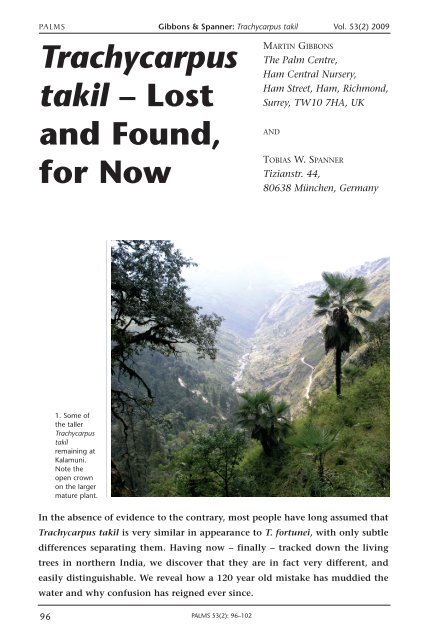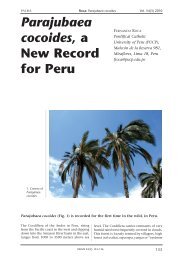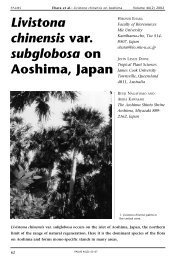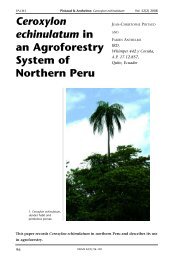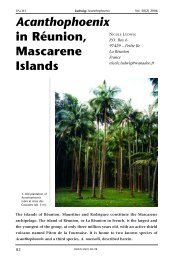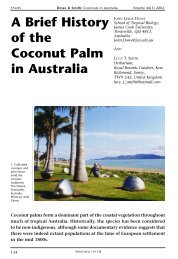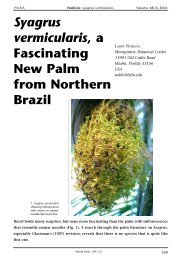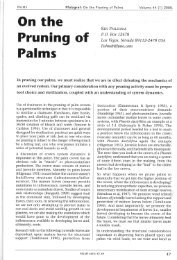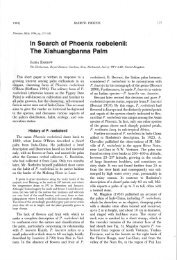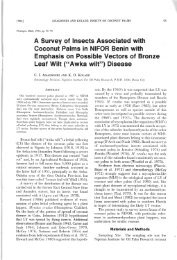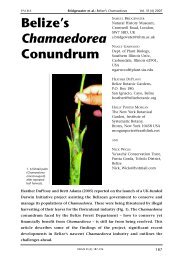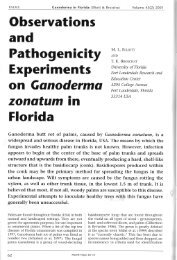Trachycarpus takil - International Palm Society
Trachycarpus takil - International Palm Society
Trachycarpus takil - International Palm Society
Create successful ePaper yourself
Turn your PDF publications into a flip-book with our unique Google optimized e-Paper software.
PALMS Gibbons & Spanner: <strong>Trachycarpus</strong> <strong>takil</strong> Vol. 53(2) 2009<br />
<strong>Trachycarpus</strong><br />
<strong>takil</strong> – Lost<br />
and Found,<br />
for Now<br />
MARTIN GIBBONS<br />
The <strong>Palm</strong> Centre,<br />
Ham Central Nursery,<br />
Ham Street, Ham, Richmond,<br />
Surrey, TW10 7HA, UK<br />
AND<br />
TOBIAS W. SPANNER<br />
Tizianstr. 44,<br />
80638 München, Germany<br />
1. Some of<br />
the taller<br />
<strong>Trachycarpus</strong><br />
<strong>takil</strong><br />
remaining at<br />
Kalamuni.<br />
Note the<br />
open crown<br />
on the larger<br />
mature plant.<br />
In the absence of evidence to the contrary, most people have long assumed that<br />
<strong>Trachycarpus</strong> <strong>takil</strong> is very similar in appearance to T. fortunei, with only subtle<br />
differences separating them. Having now – finally – tracked down the living<br />
trees in northern India, we discover that they are in fact very different, and<br />
easily distinguishable. We reveal how a 120 year old mistake has muddied the<br />
water and why confusion has reigned ever since.<br />
96<br />
PALMS 53(2): 96–102
PALMS Gibbons & Spanner: <strong>Trachycarpus</strong> <strong>takil</strong> Vol. 53(2) 2009<br />
In 1990 when Wilko Karmelk of Holland and<br />
one of us (M.G.) set off on the first of many<br />
trips investigating <strong>Trachycarpus</strong>, we did not<br />
know that the mystery we were about to<br />
uncover would not be finally solved until 15<br />
years later. That first trip to check out<br />
<strong>Trachycarpus</strong> <strong>takil</strong> was to an area in northern<br />
India on the borders of Nepal and Tibet once<br />
known as the Kumaon District (now part of the<br />
newly created province Uttarakhand). In those<br />
days we were rather naïve and hardly knew<br />
what we were looking for, nor how we would<br />
recognize it if we found it. All we had to go on<br />
was the line from Beccari (1931) about the<br />
plant’s occurrence on “Mt. Takil,” at 2400<br />
meters, where it “grows in damp oak forests in<br />
a region where snow covers the ground from<br />
November to March.” The full story of this<br />
trip can be read in Principes (Gibbons 1993),<br />
but in summary, all we found on the<br />
mountain, correctly Mt. Thalkedar, were a<br />
couple of hundred young plants. All the adults<br />
had apparently been cut down for their trunk<br />
fibers, which were made into ropes. We did<br />
find one mature tree in a nearby village, but<br />
because of our hazy knowledge of the genus,<br />
wrongly assumed it to be T. martianus.<br />
Not far from Mt. Thalkedar is the hill station<br />
of Naini Tal, used by the British early last<br />
century as a resort town away from the heat<br />
of the plains. In its streets and outside several<br />
prominent buildings such as the boat club we<br />
found many <strong>Trachycarpus</strong> — which at the time<br />
we assumed to be T. fortunei — but no more<br />
examples of any other <strong>Trachycarpus</strong> species.<br />
We were more confused than ever. In terms of<br />
shedding light on the subject, we found we,<br />
like Omar Khayyam’s young philosopher,<br />
“came out by the same door wherein we<br />
went.”<br />
Since then we have been back to the area a few<br />
times, each time adding a little more to our<br />
store of knowledge about this elusive and<br />
mysterious species. Despite the gains, however,<br />
we felt there was some fundamental issue with<br />
which we could not get to grips; different<br />
plants with features that didn’t quite match<br />
up. At one time we felt we had made a mistake<br />
in assuming the street trees in Naini Tal to be<br />
T. fortunei. Why should they be T. fortunei we<br />
reasoned, when T. <strong>takil</strong> grows (or at least grew)<br />
in the wild just a few miles distant? And yet<br />
we couldn’t really claim to be able to identify<br />
any major differences between them and the<br />
familiar T. fortunei.<br />
In another garden founded by the British and<br />
where many <strong>Trachycarpus</strong> are cultivated, the<br />
evidence appeared to point even more clearly<br />
towards T. <strong>takil</strong>. This garden is located in<br />
Chaubattia, near Ranikhet, somewhat north<br />
of Naini Tal, and is today a Government Apple<br />
Garden and Fruit Research Centre. Beccari<br />
(1931) wrote that Mr. G.B Osmaston,<br />
Conservator of Forests in Naini Tal, and Mr.<br />
E.A. Smythies, Assistant Conservator,<br />
“…supplied me with samples from plants<br />
cultivated in the Chaubattia Garden and<br />
brought there in 1877 from Badkot, 20 miles<br />
north of Chaubattia, where this palm was<br />
growing in a cool, moist valley….” At least one<br />
of the plentiful <strong>Trachycarpus</strong> found in the<br />
garden today could be old enough to be that<br />
very plant dug up in Badkot. It is a female<br />
plant, and, so we reasoned, the smaller<br />
specimens found everywhere in the garden,<br />
would most likely be its offspring and hence<br />
must all be T. <strong>takil</strong> (see also Singh et al. 1995,<br />
Kulkarni & Pawar 1996, Rana et al. 1996).<br />
In truth, no author seemed particularly clear<br />
about the differences between T. fortunei and<br />
T. <strong>takil</strong>. Even Beccari, who described T. <strong>takil</strong> as<br />
a new species (Beccari 1905, 1920), was<br />
equivocal, admitting that many of the<br />
differences were, at best, slight. We were later<br />
to realize why. As evangelists for the genus,<br />
we were under pressure to come up with<br />
2. <strong>Trachycarpus</strong> fortunei cultivated in Naini Tal,<br />
exhibiting the characteristic dense crown.<br />
97
PALMS Gibbons & Spanner: <strong>Trachycarpus</strong> <strong>takil</strong> Vol. 53(2) 2009<br />
3. Straplike ligules of<br />
cultivated <strong>Trachycarpus</strong> in<br />
the Chaubattia Garden.<br />
something definitive but were less confident<br />
than we probably sounded. Some of the<br />
features we came up with to tell T. <strong>takil</strong> apart<br />
were the asymmetrical base of the lamina (the<br />
“twisted hastula”), the brittle leaf sheath fibers<br />
and the creeping habit of the young trunk that<br />
Beccari (1931) mentioned. We even feared that<br />
the two species might have to be “lumped”<br />
into one before we could clear up the mystery.<br />
It was obvious that the species in the wild was<br />
under threat. The “great numbers, forming<br />
clumps and rows, the trees rising from 30 to<br />
50 feet high, each with its superb crown of<br />
large flabelliform leaves rattling loudly in the<br />
breeze” described by the discoverer of the<br />
species, Major Edward Madden, during his visit<br />
there in March 1847 (Madden 1853), had long<br />
since been cut down for the trunk fibers for<br />
rope-making. The locals did not understand<br />
that the fibers could be harvested for ropemaking<br />
year after year, without the necessity<br />
of killing the trees. Would the palm become<br />
extinct before being properly classified?<br />
On that first trip, in 1990, we had met a young<br />
scientist, Dr. Kholia, who was studying Indian<br />
ferns. Unbeknown to us, in the intervening<br />
years (and, he later explained, as a result of our<br />
visit) he had “converted” to palms and from<br />
time to time had done further research on T.<br />
<strong>takil</strong>. He emailed us in January 2005 to ask our<br />
opinion about it and over the course of the<br />
next few months he visited some known and<br />
some rumored locations of this species in the<br />
wild. His tantalizing, sometimes weekly<br />
bulletins persuaded us to plan a trip back to<br />
India to see if we could finally solve the<br />
mystery surrounding this palm, and we met up<br />
with him, after 15 years, in October 2005.<br />
Over the course of the busy week that we spent<br />
with Dr. Kholia, the highlight was certainly<br />
visiting a small population of adults and<br />
seedlings. Kalamuni (or Kalimundi) is a steep<br />
limestone ridge above Gini Village in<br />
Pithoragarh District, over which a small pass<br />
road winds between the towns of Girigaon and<br />
Munsyari. While adjacent slopes have long<br />
been cleared of any forest, the Kalamuni ridge<br />
is still mostly covered by majestic Cupressus<br />
torulosa, large evergreen oaks and massive<br />
Rhododendron trees. Scattered among them on<br />
SW, W and N facing slopes around 2200 m<br />
a.s.l. were mostly juvenile <strong>Trachycarpus</strong> and<br />
some mature, reproducing trees (Fig. 1). The<br />
climate here is “warm temperate” with<br />
pleasant temperatures throughout the year,<br />
excepting the occasional cold spells during<br />
winter that may be accompanied by frost and<br />
even snow, although the latter would unlikely<br />
remain for more than a few days at a time at<br />
this altitude.<br />
It was on seeing these trees (the first mature,<br />
wild T. <strong>takil</strong> that we had ever seen) that the<br />
differences between it and T. fortunei became<br />
apparent to us. Later we went back to the town<br />
of Naini Tal and realized that we had been<br />
correct the first time in identifying the street<br />
trees there as T. fortunei (Fig. 2). Alas, we<br />
learned the Indian authorities had apparently<br />
also assumed them to be T. <strong>takil</strong> and had<br />
collected seeds to plant back in the wild to<br />
buttress the flagging wild populations (Dr.<br />
Kholia, pers. comm.).<br />
So what exactly are the differences? Beccari<br />
(1905) in his original description highlighted<br />
the difference between the ligules of the two<br />
species. The ligule is the exposed tip of the<br />
leaf sheath. It is the leaf sheaths that produce<br />
98
PALMS Gibbons & Spanner: <strong>Trachycarpus</strong> <strong>takil</strong> Vol. 53(2) 2009<br />
the distinctive fibers that clothe the trunk of<br />
<strong>Trachycarpus</strong> palms. In T. fortunei, the ligule is<br />
long and splits readily into narrow straps that<br />
form a rather untidy mass at the apex of the<br />
trunk (Fig. 3). In T. <strong>takil</strong>, the ligule is very short<br />
and shallowly triangular (Fig. 4), which results<br />
in a much tidier trunk apex and leaf sheath<br />
fibers that are tightly clasping. This is clearly<br />
different from T. fortunei, and actually more<br />
like T. martianus. Secondly, the crown of T.<br />
<strong>takil</strong> is much more “open” than that of T.<br />
fortunei due to the fact that there are far fewer<br />
leaves. One can see through the crown of the<br />
former while in the latter the leaves grow<br />
much more densely and the crown normally<br />
cannot be seen through. Once these two most<br />
apparent differences are clearly explained the<br />
species can be easily distinguished.<br />
Beccari mentions the stem of young plants<br />
growing obliquely, a feature that has been<br />
much elaborated on subsequently. However,<br />
while young plants do indeed initially produce<br />
a creeping, often saxophone-shaped stem, this<br />
feature can also be observed in many T. fortunei<br />
and other <strong>Trachycarpus</strong> and may to some<br />
extent be caused by environmental factors. It<br />
is this same feature that we, and others, had<br />
observed on young plants grown from seed<br />
obtained in Naini Tal (T. fortunei as we now<br />
know) that had also contributed to our<br />
misidentification.<br />
Despite usually being compared with T.<br />
fortunei, it seems that T. <strong>takil</strong> is most closely<br />
related to T. oreophilus (Stührk 2006), which we<br />
described from northern Thailand (Gibbons &<br />
Spanner 1997) (and of which we consider T.<br />
ukhrulensis [Lorek & Pradhan 2006] of<br />
northeast India synonymous). For this reason<br />
we include it here for comparison. Table 1<br />
shows the main vegetative distinguishing<br />
features between T. fortunei, T. <strong>takil</strong> and T.<br />
oreophilus.<br />
Beccari based his 1905 description on a male<br />
plant, which grew from seed sent to him in<br />
1887 by Mr. J. F. Duthie, the superintendent<br />
of the Botanical Garden of Saharanpur, India.<br />
Beccari was a well-known botanist of his time<br />
who willingly gave palm seedlings to both<br />
botanical and private gardens (S. Quercellini,<br />
pers. comm.). There is no record of what<br />
happened to the other seeds, although we do<br />
know that there were at one time several T.<br />
4. Short, triangular ligules on <strong>Trachycarpus</strong> <strong>takil</strong> at Kalamuni.<br />
99
PALMS Gibbons & Spanner: <strong>Trachycarpus</strong> <strong>takil</strong> Vol. 53(2) 2009<br />
Table 1. Trachycarps fortunei. T. <strong>takil</strong> and T. oreophilus compared.<br />
T. fortunei T. <strong>takil</strong> T. oreophilus<br />
Diameter of woody trunk 10–25 cm (15–)20–25 cm 10–16 cm<br />
Number of live leaves to 100 ca. 20 ca. 20<br />
Leaf sheath appendage (ligule) long, ribbon-like short, triangular individual fibers<br />
not forming a<br />
ligule<br />
Hastula ca. 1.5 cm 1–2.5 cm 1–3 cm<br />
Leaf blade width 95–110 cm 100–120 cm ca. 100 cm<br />
Abaxial leaf blade colour pale, pale bluish, pale, slightly to<br />
slightly waxy strongly waxy strongly waxy<br />
Leaf blade segmentation irregular for irregular to regular regular for more<br />
ca. 3/4 for more than than 1/2<br />
1/2–3/4<br />
Segment number 40–51 45–62 55–70<br />
Segment width 3–4 cm 3–5.5 cm 2.5–4 cm<br />
Central segment length 55–80(–90) cm 67–78 cm 58–70<br />
Embryo back of seed side of seed back of seed<br />
Eophyll ca. 10 cm long, ca. 10 cm long ca. 15 cm long,<br />
4-plicate 2-plicate 2-plicate<br />
<strong>takil</strong> growing in both Rome and Florence, a<br />
few of which remain to this day.<br />
There is an old specimen at the Botanic Garden<br />
in Rome, recorded as being there in 1897 in a<br />
directory by P. R. Pirotta, the first Director, and<br />
there are a few in the grounds of La Sapienza<br />
University. Though their provenance is<br />
unknown, it is not impossible that they are<br />
the same as Beccari’s palm. We are indebted to<br />
Dr. Sergio Quercellini and his research of T.<br />
<strong>takil</strong> for this valuable information.<br />
Major Madden also distributed seeds to several<br />
of the leading nurseries of his day in Ireland<br />
and the U.K. (Morley 1972) so it is possible<br />
that some of these still survive, though there<br />
are no records.<br />
Beccari’s description of the female<br />
inflorescence and flowers was drawn from<br />
samples sent to him by Messrs. Smythies and<br />
Osmaston, Conservator and Assistant<br />
Conservator of Forests in Naini Tal, which<br />
came from plants cultivated in the Chaubattia<br />
Garden, not far from Naini Tal. As pointed out<br />
earlier, all the palms there have turned out to<br />
be T. fortunei; there are no T. <strong>takil</strong> present.<br />
Beccari’s description of the female<br />
inflorescence is equivocal: “spadices very<br />
similar in every respect to T. excelsa (fortunei),”<br />
“flowers a trifle large,” etc. Having seen the<br />
trees (or their descendents) from which those<br />
flowers may have come, we propose the<br />
explanation that Beccari may have been sent<br />
samples not of T. <strong>takil</strong> but of T. fortunei and<br />
unwittingly based his description on them.<br />
We feel it is no coincidence that the trees in<br />
both Naini Tal town and Chaubattia Garden<br />
are T. fortunei especially when one takes into<br />
account Messrs. Osmaston and Smythies’<br />
connections with both.<br />
We are aware of a few cultivated examples of<br />
T. <strong>takil</strong> in India, at Munsyari, Kausani, and<br />
Barabe (on Mt. Thalkedar). Further, we saw a<br />
tree in the Lakeside Gardens in Shillong<br />
(Meghalaya), which could well be the same<br />
species.<br />
In cultivated plants, it seems that once the<br />
growth of a trunk sets in, yearly growth rates<br />
are around 25 cm or more. In older, tall trees,<br />
growth apparently slows considerably and<br />
internodes become very short. It is worth<br />
noting that tall, old plants usually attain a<br />
larger crown with wider leaves that hold<br />
considerably more and wider segments. The<br />
establishing phase of young plants appears to<br />
be quite slow. Some cultivated plants in Italy<br />
100
PALMS Gibbons & Spanner: <strong>Trachycarpus</strong> <strong>takil</strong> Vol. 53(2) 2009<br />
retain a massive skirt of dead leaves, a feature<br />
not observed on mature trees in the wild or in<br />
cultivation in India. Climatic conditions could<br />
play a role here as well as brush fires. In<br />
general, plants in cultivation present a slightly<br />
more robust habit.<br />
It would be an interesting project to record<br />
and identify the several trees in Rome and<br />
Florence. Lorek (2006, 2007) attempted an<br />
inventory of the plants in Beccari’s garden in<br />
Florence, but we feel with misleading results.<br />
Morici (2008) claimed that all T. <strong>takil</strong> in the<br />
garden have perished but, like Lorek,<br />
overlooked a mistake in an unpublished paper<br />
by Cellai Ciuffi et al. (1999) that misidentified<br />
a palm that perished in the harsh winter of<br />
1985 (clearly a Washingtonia) as T. <strong>takil</strong>.<br />
We strongly suspect that most if not all other<br />
plants labeled “T. <strong>takil</strong>” in cultivation around<br />
the world are, in fact, T. fortunei or, in some<br />
cases, T.wagnerianus (Stähler & Spanner 2007).<br />
There has been considerable discussion on the<br />
status of this species (Singh et al. 1995,<br />
Kulkarni & Pawar 1996, Rana et al. 1995, 1996,<br />
Husain & Garg 2004, Gibbons et al. 2008). In<br />
the wild, we are aware of just three populations<br />
of T. <strong>takil</strong>, two of which contain only juveniles,<br />
the third with several adults and many<br />
juveniles. Recently there have been reports<br />
and photographs of a larger population of wild<br />
trees in the general area of the small<br />
population we saw at Kalamuni (Riphagen,<br />
pers. comm.). This is exciting indeed and<br />
perhaps worthy of a trip to check it out. It is<br />
not unlikely that there are other, unknown,<br />
populations in more remote areas, perhaps<br />
even over the close-by border in Nepal, but<br />
this is purely speculative.<br />
Nevertheless, T. <strong>takil</strong> must be considered<br />
threatened (IUCN 2001) and its future seems<br />
in serious doubt, it having gone from “great<br />
numbers” to extreme rarity in a little over a<br />
hundred years. Serious efforts should be made<br />
by the authorities in India to conserve those<br />
trees that are left. This should begin with an<br />
understanding of the clear differences between<br />
it and T. fortunei, followed by the removal of<br />
all T. fortunei seedlings that have apparently<br />
been transplanted into the wild. These efforts<br />
should also include the controlled collection<br />
of seeds from wild populations for cultivation<br />
and perhaps an eventual re-introduction into<br />
the wild. Finally, it is crucial to gain the<br />
support of villagers local to where T. <strong>takil</strong> clings<br />
on in the wild in an effort to prevent any more<br />
trees from being cut down. Dr. Kholia has first<br />
hand experience of this destruction; he has<br />
monitored the young plants on Mt. Thalkedar,<br />
watched them grow over a period of several<br />
years to around 50 cm of trunk, and then seen<br />
them cut down for their few pitiful fibers.<br />
Harvest not destroy! If provision of free rope<br />
would take the pressure off, we are confident<br />
that there are a number of individuals and<br />
palm societies who would be delighted to<br />
contribute funds.<br />
Acknowledgments<br />
We are deeply indebted to Dr. B.S. Kholia for<br />
his many contributions to our research of T.<br />
<strong>takil</strong>. We would also like to thank Sergio<br />
Quercellini for sharing his findings on<br />
cultivated plants in Italy, and Herbert<br />
Riphagen, who provided valuable information<br />
on the status of wild populations.<br />
LITERATURE CITED<br />
BECCARI, O. 1905. Le palme del genere<br />
“<strong>Trachycarpus</strong>.” Webbia 1: 41–68 .<br />
BECCARI, O. 1920 Recensione delle palme del<br />
vecchio mondo appartenenti alla tribù delle<br />
Corypheae con descrizione delle specie e<br />
varietà nuove che vi appartegnono. Webbia<br />
5: 5–70.<br />
BECCARI, O. 1931. Asiatic <strong>Palm</strong>s – Corypheae<br />
(ed. U. Martelli). Ann. Roy. Bot. Gard.<br />
(Calcutta) 13: 1–356.<br />
CELLAI CIUFFI, G., A. GRIGIONI AND P. LUZZI. 1999.<br />
Il complesso die Giardini di Villa Beccari,<br />
storia, evoluzione, ipotesi di sistemazione.<br />
Unpublished work available at the Botanic<br />
Garden, Florence.<br />
GIBBONS, M. 1993. Trekking on the <strong>Trachycarpus</strong><br />
trail. Principes 37: 19–25.<br />
GIBBONS, M. AND T. SPANNER. 1997. <strong>Trachycarpus</strong><br />
oreophilus – The Thailand <strong>Trachycarpus</strong>.<br />
Principes 41: 201–207.<br />
GIBBONS, M., T. SPANNER AND B.S. KHOLIA. 2008.<br />
<strong>Trachycarpus</strong> <strong>takil</strong> Becc. in Kumaon. Current<br />
Science 94: 444–446.<br />
HUSAIN, T. AND A. GARG. 2004. <strong>Trachycarpus</strong> <strong>takil</strong><br />
Becc. is not a ‘rare’ palm. Current Science 86:<br />
633–634.<br />
IUCN. 2001. Red List Categories and Criteria<br />
version 3.1.<br />
KULKARNI, A.R. AND B.S. PAWAR. 1996. Comments<br />
on ‘A critical appraisal of the type locality of<br />
a rare palm from Kumaon Himalaya, India’.<br />
Current Science 70: 19–20.<br />
101
PALMS Gibbons & Spanner: <strong>Trachycarpus</strong> <strong>takil</strong> Vol. 53(2) 2009<br />
LOREK, M. 2006. Aktueller Bestand der<br />
Arecaceae im Garten der Villa Beccari<br />
(Florenz, Italien). Hortus Exoticus 2: 10–22.<br />
LOREK, M. AND K.C. PRADHAN. 2006. A new<br />
species of <strong>Trachycarpus</strong> (Arecaceae), with<br />
remarks on its unusual habitat. Bot. Jahrb.<br />
Syst. 126: 419–426.<br />
LOREK, M. 2007. The Indian species<br />
<strong>Trachycarpus</strong> <strong>takil</strong> in the garden of Villa<br />
Beccari, Florence, Italy. Current Science 93:<br />
295–297.<br />
MADDEN, E. 1853. On the occurrence of palms<br />
and bambus, with pines and other forms<br />
considered northern, at considerable<br />
elevations in the Himalaya. Trans. Bot. Soc.<br />
Vol. 1V. 183–195.<br />
MORICI, C. 2008. Villa Beccari – one century<br />
later. <strong>Palm</strong>s 52: 175–179.<br />
MORLEY, B. 1972. Edward Madden. RHS Journal<br />
97: 203–206.<br />
RANA, T.S., T. HUSAIN AND R.R. RAO. 1995. A<br />
critical appraisal of the type locality of a rare<br />
palm from Kumaon Himalaya, India.<br />
Current Science 68: 590–592.<br />
RANA, T.S., T. HUSAIN AND R.R. RAO. 1996.<br />
Comments on ‘A critical appraisal of the<br />
type locality of a rare palm from Kumaon<br />
Himalaya, India.’ Current Science 70: 20.<br />
SINGH, D. K., SURENDA SINGH AND S. K. MURTI.<br />
1995. <strong>Trachycarpus</strong> <strong>takil</strong> Becc. (Arecaceae) –<br />
a rare, endemic palm of Kumaon Himalaya,<br />
India. Indian Journal of Botany 18: 332–336.<br />
STÄHLER, M. AND T. SPANNER. 2007. Winterharte<br />
<strong>Palm</strong>en. Medemia Verlag, Berlin.<br />
STÜHRK, C. 2006. Molekularsystematische<br />
Studien in der Subtribus Thrinacinae, mit<br />
besonderer Berücksichtigung der Gattung<br />
<strong>Trachycarpus</strong> H. Wendl. (Arecaceae).<br />
Diplomarbeit im Studienfach Biologie.<br />
Biozentrum Klein Flottbek und Botanischer<br />
Garten, Hamburg.<br />
Genera <strong>Palm</strong>arum 2 Wins Award<br />
In early May, the Council on Botanical and Horticultural Libraries announced that Genera<br />
<strong>Palm</strong>arum: the Evolution and Classification of <strong>Palm</strong>s, published by the Royal Botanic Gardens Kew<br />
in association with the IPS and the LH Bailey Hortorium had been given the 2009 Annual<br />
Literature Award. The award recognizes both the authors and the publisher of a work that<br />
makes a significant contribution to the literature of botany and horticulture. GP2 has won the<br />
Technical Category. Larry Currie, Librarian of the California Academy of Sciences Library noted<br />
that “the high production quality of this book, coupled with the comprehensive coverage of<br />
the subject, will certainly make this the standard reference on palms for many years to come.”<br />
Copies of this award-winning reference book are available from the IPS website, www.palms.org.<br />
102


